My son and I sometimes meet a friend at the park and have lunch together. She’s as cute as a button. Here she is:
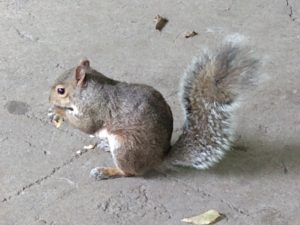
We named her Chippy because the first time we saw her, she came to our picnic table and we fed her chips (baked, no salt).1)For future reference, we should not feed squirrels chips. The park later closed for several months to work on renovations.
When the park re-opened, I went for a walk there. Once I rounded a corner, three squirrels ran up and greeted me. I was pleasantly surprised. I stopped briefly, bent down, said hello, then kept walking. I turned my head and looked back. The cute little buggers were following me. So, I turned and stopped. One squirrel came closer. It was Chippy! I bent down and she and I had a friendly conversation. Here she is greeting me:
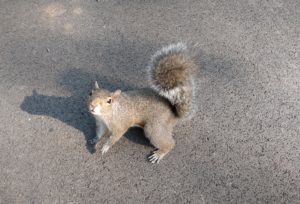
The Appalachian Mountains are home to the red, grey, fox, and flying squirrels. Surprisingly, over 300 squirrel species exist all over the world. These species are separated into seven families, the most common being: the ground squirrel, the flying squirrel, and the tree squirrel.
The squirrel is a rodent of the genus Sciurus. The animal’s name derives from the ancient Greek word, skiouros, meaning “shadow” or “shade” tail. The interpretation is “he who sits in the shadow of his tail.”2)Squirrel Place. 2010. “History.” Wayback Machine. Dec 27. In the 1300s, the Anglo-Normans borrowed from Old French’s esquireul and referred to the creature as esquirel, thus the origin of our modern word, “squirrel.”
This article will focus on a well-known tree squirrel: the eastern grey (Sciurus Carolinensis). Fossil evidence suggests the grey squirrel has been around for over thirty-five million years.
Physical Characteristics
The grey squirrel measures one to two feet long. About half of that size is the tail. Adults weigh between fourteen and twenty-five ounces. Their coat is smooth with greyish-white coloring and a white or cream-colored underside. The outer legs can be grey or “dusky red.” Their fur color sometimes changes with the seasons.
A squirrel’s brain is “about the size of a walnut.”3)Squirrel Place. 2010. “History.” Wayback Machine. Dec 27. The eyes are situated high on either side of the head, enabling them to survey surroundings without moving their head. Research suggests they might see in color. A squirrel’s teeth never stops growing. The front teeth grow about six inches a year, but are worn down by chewing and scraping. Squirrels chew on tree branches, bark, and also power lines (sometimes causing power outages). Not to mention, they use their teeth as tools for nuts and so forth.
Sweat glands are located on the squirrel’s feet between the pads and the toes. These glands release a sweat scent that marks trees in their area. The smell helps affirm their territory and tells other squirrels to skedaddle.
The grey squirrel’s tail makes it “the most recognized mammal on Earth.”4)Wildlife Online. n.d. “Grey Squirrel.” Wildlife Online. Accessed April 2022. The squirrels use this appendage for balance as they maneuver around. The backend also guides them safely if they fall. In winter, the tail becomes a warm, cozy blanket. Squirrels also move and flick the tail to communicate or distract.
Homes and Territory
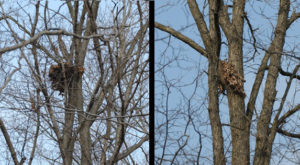
The grey squirrel lives in dens called “dreys,” located mostly in trees. The dreys are round, about a foot in diameter, and assembled with twigs, leaves, moss, thistledown, etc. They are built high atop tree forks and branches, with an eventual cover. Sometimes squirrels make their homes in abandoned birds’ nests and occasionally nest in burrows. They may build several dens across a territory. If a den is rife with fleas or other parasites, a squirrel simply moves to a new nest. Similarly, if threat or danger looms, another nest is waiting.
A grey squirrel’s territory covers between five to twenty-five acres, marked off using sweat scent and urination on trees. The animal is vigilant and passionately defends a territory. Familiar squirrels may be tolerated in the area but unwelcomed squirrels are chased away and fought. Any area outside the territory is a squirrel’s danger zone.
Behavior
Squirrel activity varies with the seasons. They are highly active during autumn days. In winter, their energy slows to about four hours a day. Activity increases again in spring. In summertime, squirrels are energetic until the day grows hot, then they retreat until just before sunset. In any season, they rarely leave their nest at night. They do not hibernate.
Grey squirrels have “highly sophisticated communication” skills.5)Steppan, Scott J. and Shawn M. Hamm. 2006. “Sciuridae: Squirrels.” Tree of Life Project. May 13. They produce several “acoustically distinct calls”6)Wildlife Online. n.d. “Grey Squirrel.” Wildlife Online. Accessed April 2022. like “harsh squalls, warning barks, chucks, mews, purrs, and tooth chattering”7)North Carolina Wildlife Resource Commission. n.d. “Eastern Gray Squirrel.” North Carolina Wildlife Resource Commission. Accessed May 2022. that are often accompanied by a little bit of foot stomping and tail-flicking.
Grooming is important for grey squirrels. Males take longer to groom than females. Tree squirrels in general are “the cleanest animal in the rodent family.”8)Squirrel Place. 2010. “History.” Wayback Machine. Dec 27. They are mostly a solitary animal and live alone. During extreme cold, however, they share a den with fellow squirrels. Once the weather warms, the company leaves. These little creatures have a hierarchy structure, too. Dominant and underling squirrels sometimes fight by chasing and wrestling. Most fights occur during breeding season. They also play, by chasing each other up, down, and across land and trees.
Grey squirrels have learned to coexist with humans. They have an extraordinary memory, paying “close attention to our faces and the hand that holds”9)Graham, Ada and Frank Graham. 1985. We Watch Squirrels. New York: Dodd, Mead & Company. the food – which might explain how Chippy and her friends recognized me.
Grub & Stockpiling
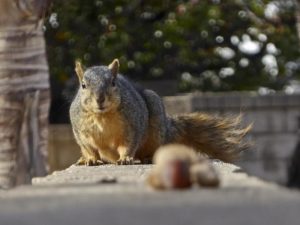
A squirrel’s diet consists mostly of seeds, berries, nuts, and other plant materials. They eat mushrooms and lichen, too. Extra food is stored in cheek pouches. On rare occasions, when food is scarce, they eat insects, eggs, baby birds, and animal remains. Squirrels also eat human food found in our garbage. Typically, an adult squirrel consumes one pound of food every week. Squirrels also eat foods that are poisonous to humans, perhaps due to their “short digestive tract which seems to handle these compounds.”10)Squirrel Place. 2010. “Frequently Asked Questions.” Squirrel Place. Dec 27.
Squirrels add scent to a nut “by licking it or rubbing on its face.”11)Squirrel Place. 2010. “History.” Wayback Machine. Dec 27. Doing so helps them find the nut, even after it’s buried. They also have precise spatial memory, and often use “landmarks” to pinpoint a stash. Grey squirrels hide food in various places, because, if one stash is raided or gone, other stashes are nearby. They can stockpile “several thousand caches per season.”12)Animal Spot. n.d. “Eastern Gray Squirrel.” Animal Spot. Accessed April 2022.
Reproduction and Birth
Males traverse around 247 acres of ground to find a mate during mating season – and they are relentless. A group of males will zealously chase after one female. But it’s all up to her. She chooses the strongest male as a mate, “but is unlikely to breed with that male again” to safeguard the species from inbreeding.13)Squirrel Place. 2010. “History.” Wayback Machine. Dec 27. The male bolts after mating and leaves the female to raise the babies.
Females cannot breed until after their first year. They have one or two litters a year with about two to five babies. The gestation period is 42 to 45 days. Babies are called “kittens” or “pups.” They’re born hairless with eyes and ears that are “sealed shut.”14)Otfinoski, Steven. 2011. Squirrels. New York: Marshall Cavendish Benchmark. They only weigh about two ounces at birth. Their eyes and ears open at five weeks old. After seven weeks, kittens can leave the drey to explore. Young squirrels are quite playful, wrestling, rolling, and zipping around. They are usually weaned at ten weeks old, leave the nest at about three months, and are mature at ten months to a year old.
Longevity, Health, and Dangers
Grey squirrels have a life expectancy of between two to six years in the wild. Urban squirrels have shorter lifespans, mostly due to automobiles. Squirrels are susceptible to several diseases and parasites. The Botfly larvae creates polyps and lumps on the squirrel’s body. Lice, ticks, and fleas also affect a squirrel’s health. The grey squirrel has developed immunity from diseases like Squirrelpox but they are greatly affected by the viral illness Fibromatosis (causes tumors on the body).
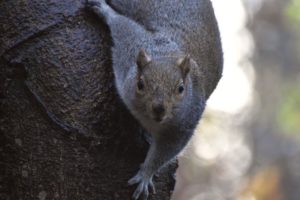
Automobiles are arguably a squirrel’s primary danger. Some people consider the animal a pest and exterminate them for this reason. The grey squirrel’s predators are foxes, hawks, coyotes, raccoons, snakes, and bobcats. When threatened, a squirrel’s first impulse is to freeze. If threatened on the ground, the animal scurries away or escapes up a tree. If threatened in a tree, the squirrel presses its body tightly against the bark and spirals up and down the tree trunk.
Conclusion
I know some people don’t particularly care for squirrels. I had a neighbor once who said they’re nothing but “tree rats,” and, if he had his way, he’d shoot every one of them. They can be a bit of a nuisance sometimes. But if they weren’t around – truly extinct – wouldn’t a majority of us miss them? I also know hunters pursue them for food or fur. That’s their choice and I don’t judge. When I was a little girl, my father hunted them. They were oftentimes the only food we had to eat. But that was then.
These days, I continue to marvel at the way they sit upright while munching on food, their little “hands” holding onto and turning an acorn or berry. Or I’ll giggle while watching them scamper across grasses and trees. William Butler Yeats’ short poem “To A Squirrel At Kyle-Na-No” puts it nicely:
Come play with me;
Why should you run
Through the shaking tree
As though I’d a gun
To strike you dead?
When all I would do
Is to scratch your head
And let you go.
**Featured image by Peter Lloyd on Unsplash
Crediting the following sources for this article:
Online:
“Eastern Gray Squirrel” by Animal Spot.
“Squirrels on the Appalachian Trail” by Steve Burge on AppalachianTrail.com.
“Understand grey squirrels” by Stephen Harris on Discover Wildlife
“Eastern Gray Squirrel” by the North Carolina Wildlife Resource Commission.
“Squirrel Tracks” by Northern Bushcraft.
“Frequently Asked Questions” by Squirrel Place on Wayback Machine, December 27, 2010
“History” by Squirrel Place on Wayback Machine, December 27, 2010
“Sciuridae: Squirrels.” Scott J. Steppan and Shawn M. Hamm. 2006. Tree of Life Project.
“Grey Squirrel” by Wildlife Online.
Books:
Ada Graham and Frank Graham. 1985. We Watch Squirrels. New York: Dodd, Mead & Company.
Steven Otfinoski. 2011. Squirrels. New York: Marshall Cavendish Benchmark.
References
| ↑1 | For future reference, we should not feed squirrels chips. |
|---|---|
| ↑2, ↑3, ↑8, ↑11, ↑13 | Squirrel Place. 2010. “History.” Wayback Machine. Dec 27. |
| ↑4, ↑6 | Wildlife Online. n.d. “Grey Squirrel.” Wildlife Online. Accessed April 2022. |
| ↑5 | Steppan, Scott J. and Shawn M. Hamm. 2006. “Sciuridae: Squirrels.” Tree of Life Project. May 13. |
| ↑7 | North Carolina Wildlife Resource Commission. n.d. “Eastern Gray Squirrel.” North Carolina Wildlife Resource Commission. Accessed May 2022. |
| ↑9 | Graham, Ada and Frank Graham. 1985. We Watch Squirrels. New York: Dodd, Mead & Company. |
| ↑10 | Squirrel Place. 2010. “Frequently Asked Questions.” Squirrel Place. Dec 27. |
| ↑12 | Animal Spot. n.d. “Eastern Gray Squirrel.” Animal Spot. Accessed April 2022. |
| ↑14 | Otfinoski, Steven. 2011. Squirrels. New York: Marshall Cavendish Benchmark. |
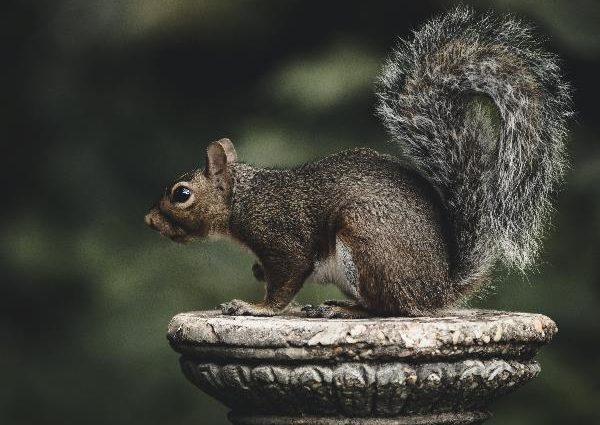
Although this is a very familiar rodent, I learned a lot from this piece. We have a population of gray squirrels who frequent our huge oak tree in the back yard. I find them amusing, except for when they take to snacking on our tomatoes in the garden. In Western NC, we also have white squirrels, a genetic anomaly of the gray. Brevard has a yearly white squirrel festival.
I came across images of the white squirrel while doing research for this piece. They’re striking little creatures! I often catch a grey squirrel in one of our bird feeders just munching away. They’re certainly persistent, crafty food thieves. But they’re so darn cute. The other day, I saw a chipmunk (We called them “ground squirrels” when I was little.) roaming around, and it made me smile. I find the “other worlds” that surround us fascinating.